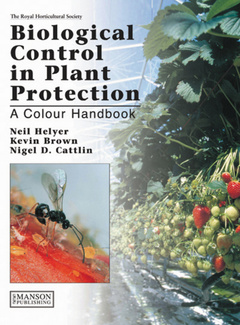Biological Control in Plant Protection (2nd Ed.) A Colour Handbook, Second Edition
Auteurs : Helyer Neil, Cattlin Nigel D., Brown Kevin C.

There has been a large increase in the commercial use of integrated crop/pest management methods for pest and disease control on a wide range of crops throughout the world since the first edition of this book. The completely revised second edition of the bestselling Biological Control in Plant Protection: A Color Handbook continues the objective of providing a handbook with profiles and full-color photographs of as many examples of biological control organisms from as wide a global area as possible. It is designed to help readers anticipate and recognize specific problems of pest management and then resolve them using the natural enemies of pests?parasites, predators, and pathogens.
The authors first describe the impact of predator-prey relationships on host plant species in arable, orchard, and protected environments. The main sections of the book include profiles of pests, beneficial arthropods (insects and mites), and beneficial pathogens (bacteria, fungi, viruses, and nematodes), featuring a tabular pest identification guide. Descriptions of biocontrol organisms are divided into four sections: species characteristics, lifecycle, crop/pest associations, and influences of growing practices. The text is illustrated throughout with color photographs of the highest quality.
This revised edition helps readers more fully understand the concepts and practice of biological control and integrated pest management. All chapters have been updated and expanded, and more than 300 new photographs have been added. The second edition covers new beneficial organisms and pest profiles, and it includes a new chapter on the practical aspects and application of biological control. It also contains a new final chapter that puts biological control in perspective, discussing interactions that occur when using biocontrol for population management as well as some of the possible mechanisms of biocontrol.
The practice and application of biological control. Biological control in various cropping systems. Biology of some common target pests. Arthropod biological control agents. Beneficial pathogens. Biological control in perspective. Glossary. References. Further reading. Useful websites.
Neil Helyer joined the Glasshouse Crops Research Institute as an entomologist in 1976. He joined Fargro Ltd. as their Integrated Pest Management Specialist in 1995. Currently, Neil visits horticulturalists to develop and monitor IPM programs, the majority of which are specifically designed for each site and crop. These include protected salad crops, soft fruit, ornamentals, and hardy nursery stock, as well as botanic gardens (RBG Kew, RHS Wisley, etc.) and interior plant landscapes. Neil holds a BASIS certificate and ensures that his technical information base is kept up to date by being a member of the BASIS Professional Register.
Nigel Cattlin joined ICI’s Plant Protection Division at Jealott’s Hill Research Station in 1963. He later formed and led its photographic unit, carrying out research projects with high-speed, time-lapse, and aerial photography. In 1981 Nigel established Holt Studios, an independent company providing a specialist photographic service to the agricultural industry, government organizations, and publishers. This resource is widely used for text and reference books, trade and consumer magazines, and advertising. Holt Studios’ main business was transferred to another agency in 2005, but Nigel continues to take photographs in his specialized fields of interest.
Dr. Kevin Brown joined the Sittingbourne Laboratory of Shell Research Ltd. in 1986 as an ecotoxicologist. He was a founding member of the Beneficial Arthropod Testing Group (BART) in 1988 and is an author of many of the current regulatory ring-tested methods for nontarget arthropods. In 1989 he established Ecotox Limited, a contract testing facility. He now works as an independent ecotoxicologist and environmental consultant conducting and refining risk assessments, monitoring higher tier studies on behalf of clients, and participating in multifacility research projects.
Date de parution : 04-2014
Ouvrage de 262 p.
17.8x25.4 cm
Thèmes de Biological Control in Plant Protection :
Mots-clés :
Spider Mite; Predatory Mites; Biological control; Parasitoid Wasp; Beneficial organisms; Entomopathogenic Fungi; Sustainable environment; Otiorhynchus Sulcatus; Biopesticide; Entomopathogenic Nematodes; Agriculture; Feltiella Acarisuga; Horticulture; Trialeurodes Vaporariorum; Pathogens; Polyphagous Predators; Beneficial pathogens; Phasmarhabditis Hermaphrodita; Pest identification; Phytoseiulus Persimilis; Plant damage symptoms; Aphidoletes Aphidimyza; Episyrphus Balteatus; Chrysoperla Carnea; Pandora Neoaphidis; Woolly Apple Aphid; Aphidius Ervi; Predatory Bugs; Scale Insects; Powdery Mildew; Fruit Tree Red Spider Mite; Parasitoid Larva; Encarsia Formosa; Aphidius Colemani; Diglyphus Isaea



